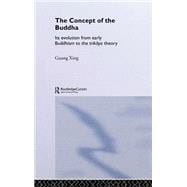
Note: Supplemental materials are not guaranteed with Rental or Used book purchases.
Purchase Benefits
Looking to rent a book? Rent The Concept of the Buddha: Its Evolution from Early Buddhism to the Trikaya Theory [ISBN: 9780415333443] for the semester, quarter, and short term or search our site for other textbooks by Xing; Guang. Renting a textbook can save you up to 90% from the cost of buying.
| Acknowledgements | x | ||||
| Abbreviations | xi | ||||
| Glossary | xiii | ||||
| Introduction | 1 | (6) | |||
|
1 | (2) | |||
|
3 | (4) | |||
| 1 The concept of the Buddha in early Buddhism | 7 | (12) | |||
|
7 | (6) | |||
|
13 | (6) | |||
| 2 The concept of the Buddha in the early Indian Buddhist Schools (I) The Sarvastivada | 19 | (34) | |||
|
19 | (4) | |||
|
23 | (12) | |||
|
35 | (9) | |||
|
44 | (1) | |||
|
45 | (3) | |||
|
48 | (1) | |||
|
49 | (1) | |||
|
50 | (3) | |||
| 3 The concept of the Buddha in the early Indian Buddhist schools (II) The Mahasamghika and other schools | 53 | (16) | |||
|
53 | (13) | |||
|
66 | (3) | |||
| 4 The origin and development of the dharmakaya | 69 | (32) | |||
|
69 | (6) | |||
|
75 | (26) | |||
|
75 | (5) | |||
|
80 | (2) | |||
|
82 | (4) | |||
|
86 | (1) | |||
|
87 | (1) | |||
|
88 | (6) | |||
|
94 | (2) | |||
|
96 | (5) | |||
| 5 The origin and development of the Sambhogakaya | 101 | (35) | |||
|
101 | (3) | |||
|
104 | (2) | |||
|
106 | (13) | |||
|
119 | (5) | |||
|
124 | (5) | |||
|
129 | (4) | |||
|
133 | (3) | |||
| 6 The origin and development of the nirmanakaya | 136 | (11) | |||
|
136 | (3) | |||
|
139 | (8) | |||
| 7 The attributes of the Buddha and other Buddhas in early and middle Mahayana sutras | 147 | (32) | |||
|
147 | (7) | |||
|
154 | (2) | |||
|
156 | (3) | |||
|
159 | (4) | |||
|
163 | (2) | |||
|
165 | (6) | |||
|
171 | (3) | |||
|
174 | (5) | |||
| Conclusion: The five basic stages in the development of the concept of the Buddha | 179 | (3) | |||
| Appendix: Chronology of Chinese translation of Mahayana sutras and sastras | 182 | (5) | |||
| Notes | 187 | (46) | |||
| Select bibliography | 233 | (14) | |||
| Index | 247 |
The New copy of this book will include any supplemental materials advertised. Please check the title of the book to determine if it should include any access cards, study guides, lab manuals, CDs, etc.
The Used, Rental and eBook copies of this book are not guaranteed to include any supplemental materials. Typically, only the book itself is included. This is true even if the title states it includes any access cards, study guides, lab manuals, CDs, etc.